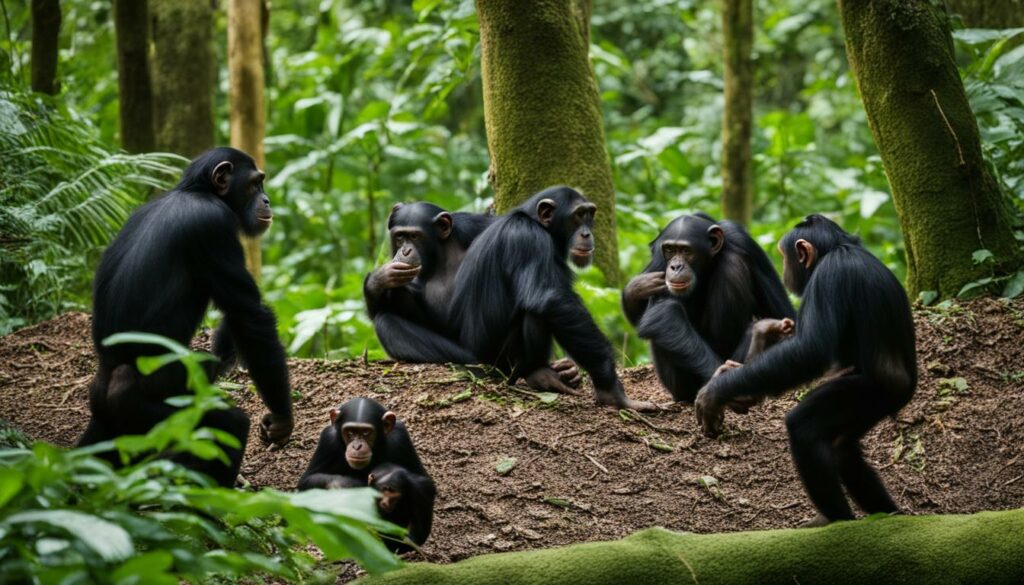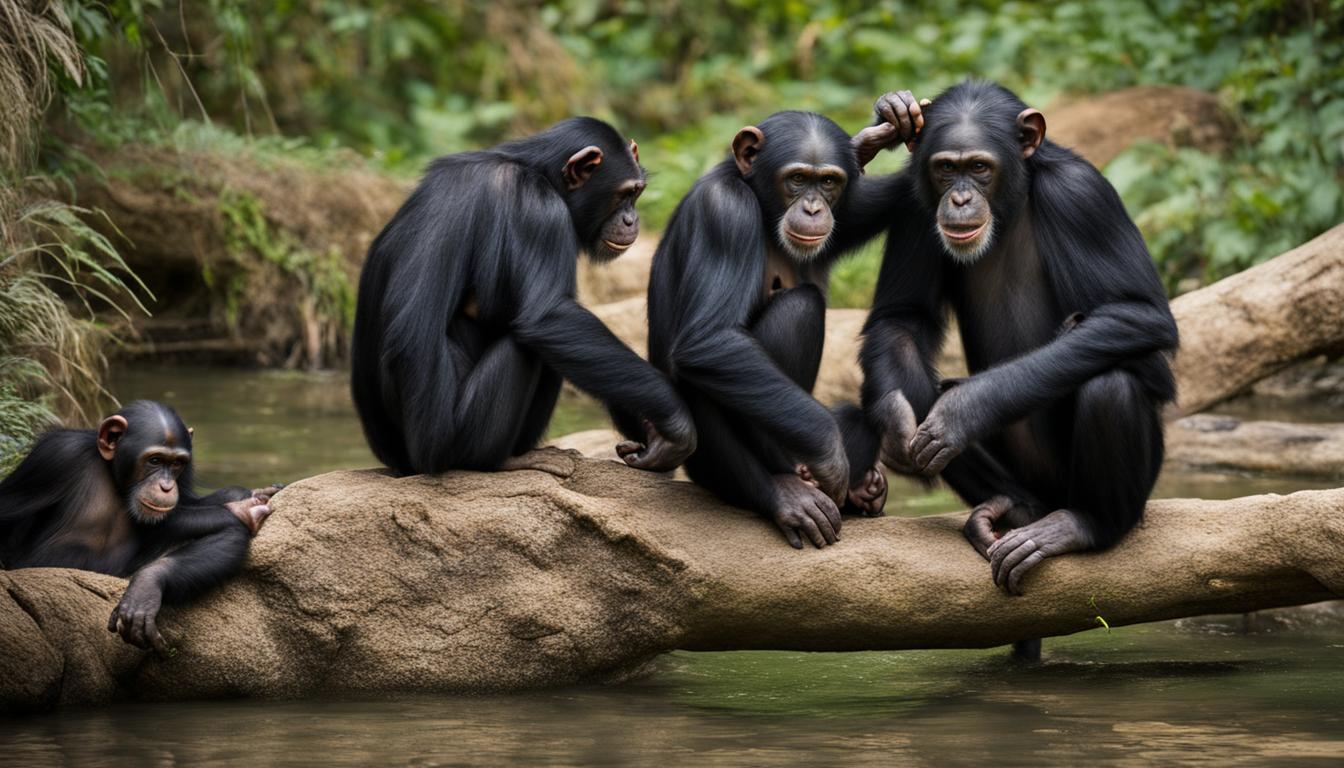Welcome to our exploration of the fascinating world of chimpanzee group dynamics and the social behavior of these incredible animals. Chimpanzees, known for their intelligence and complex social structures, live in extended family groups consisting of 20 to 120 individuals. Their social organization follows a fission-fusion pattern, where they form smaller interchangeable groups and periodically come together.
In these chimpanzee groups, females give birth approximately once every five years, and infants are lovingly cared for by their mothers and other related females. Mothers and sons often form lifelong bonds, while females migrate to neighboring communities upon reaching sexual maturity. Chimpanzees are highly social animals, and they learn from each other through imitation and observation, including the acquisition of tool use and hunting techniques.
Bonding behaviors such as grooming and embracing play a crucial role in their social interactions. Through these behaviors, chimpanzees form strong bonds and provide comfort and consolation to one another. Their social lives are complex, displaying a wide range of behaviors from affectionate to violent.
Join us as we delve deeper into the hierarchical structure, communication, cooperation, social learning, and culture of chimpanzee groups. Discover how these intelligent creatures navigate their communities and establish territories, showcasing the diverse and intricate dynamics of their social lives.
Chimpanzee Hierarchical Structure
The social structure within chimpanzee groups is built upon a hierarchical system that helps establish dominance and maintain order. The hierarchy is evident in both male and female chimpanzees, although the alpha male holds the highest position of power within the group. The alpha male achieves this status through strong alliances and grooming, which helps solidify their control.
Below the alpha male, there are several other males who also hold positions of relative power. These males may occasionally challenge the alpha male’s dominance, leading to power struggles within the group. In a similar manner, female chimpanzees also have a hierarchical structure, led by the alpha female. However, it is important to note that the alpha male typically outranks the alpha female in terms of dominance.
The hierarchical structure within chimpanzee groups is not simply about power; it also influences reproductive success and access to resources. Higher-ranking females tend to have more reproductive success and better access to food sources, which in turn increases the chances of their offspring achieving higher status within the group.
| Dominance Level | Male | Female |
|---|---|---|
| Highest | Alpha Male | Alpha Female |
| Second Highest | Subordinate Males | Subordinate Females |
| Lower Ranks | Subordinate Males | Subordinate Females |
The hierarchical structure of chimpanzee groups provides a framework for social order and helps regulate behaviors within the group. It also highlights the importance of alliances, grooming, and access to resources in maintaining dominance and reproductive success. Understanding the chimpanzee dominance hierarchy provides valuable insights into the complexities of their social dynamics and interactions.
Communication and Social Interactions
Communication and social interactions play a crucial role in the dynamics of chimpanzee groups. These intelligent creatures have developed various methods of communication to convey information and express emotions. From vocalizations to tactile rituals, chimpanzees engage in a complex web of social interactions that strengthen bonds and foster cohesiveness within the group.
Chimpanzees have a rich language of calls and vocal expressions that serve different purposes. They use warning calls to alert the group of potential predators, and they express a range of emotions such as excitement, fear, and contentment through their vocalizations. These vocalizations are key in coordinating group activities and maintaining social cohesion.
Chimpanzees communicate through tactile rituals as well, using grooming and embracing as forms of bonding and comfort. Grooming plays a vital role in their social interactions, not only helping them maintain personal hygiene but also promoting social bonding within the group. Through grooming, chimpanzees build trust and establish social hierarchies, reinforcing their social structure and relationships.
The Importance of Bonding
Bonding among chimpanzees is crucial for the overall well-being of the group. Through bonding behaviors like grooming and embracing, chimpanzees strengthen social ties, reduce tension, and foster cooperation. Grooming sessions provide an opportunity for individuals to remove dirt and parasites from each other’s fur, while also creating a sense of trust and security.
Chimpanzees also engage in communal activities such as foraging and hunting, which further strengthen their social bonds. Working together to find food and protect their group enhances cooperation and collaboration among group members. By sharing resources and knowledge, chimpanzees ensure the survival and success of their community.
Summary
Communication and social interactions are fundamental aspects of chimpanzee group dynamics. Through vocalizations and tactile rituals, chimpanzees convey information, express emotions, and build strong bonds within their group. Grooming and embracing play a crucial role in fostering trust and maintaining social hierarchies. Additionally, communal activities such as foraging and hunting promote cooperation and collaboration among group members, ensuring the well-being and survival of the chimpanzee community.
Aggression and Cooperation in Chimpanzee Groups
Chimpanzee groups exhibit a fascinating balance between aggression and cooperation. While aggression is a common aspect of their behavior, they also engage in various cooperative activities that contribute to the overall survival and success of their group. Understanding the interplay between aggression and cooperation provides valuable insights into the dynamics of chimpanzee societies.
Aggression among chimpanzees primarily arises from competition for resources, such as food and territory. Dominant males often display aggressive behaviors to maintain their position within the group hierarchy, while subordinate males may challenge the dominant male’s authority. Aggressive encounters can range from vocal displays and intimidation to physical violence, including aggressive body language and physical attacks.
However, chimpanzees also demonstrate remarkable levels of cooperation within their groups. They form alliances and coalitions to defend their territory from neighboring groups and may cooperate during hunting activities. Cooperative hunting involves a group of males working together to capture and kill small prey, such as monkeys. Through cooperation, they increase their chances of success and gain access to valuable food resources.
“Cooperation plays a vital role in their group dynamics and survival.”
In addition to hunting, chimpanzees cooperate in other aspects of their lives, such as caring for infants and communal foraging. Adult females, in particular, engage in cooperative behaviors by sharing childcare responsibilities and providing support to each other. This cooperative social structure helps in reducing conflicts and maintaining harmony within the group.
| Aggression | Cooperation |
|---|---|
| Competition for resources | Alliances and coalitions |
| Dominant males displaying aggression | Cooperative hunting |
| Physical violence and intimidation | Communal foraging |
Overall, the interplay between aggression and cooperation in chimpanzee groups is a dynamic and complex phenomenon. While aggression serves as a means of maintaining dominance and acquiring resources, cooperation enhances their survival prospects and strengthens social bonds within the group. By striking a delicate balance between these two behaviors, chimpanzees navigate their social landscape and adapt to the challenges of their environment.
Social Learning and Culture in Chimpanzee Groups
Chimpanzees, our closest living relatives, exhibit fascinating social learning and cultural behaviors within their groups. Through observation and imitation, chimpanzees acquire and pass down knowledge, showing a primitive form of culture. These intelligent primates have distinct cultural differences across populations, indicating the transmission of behaviors and traditions over generations.
One remarkable example of social learning in chimpanzees is their use of tools. Different populations have developed unique tool-use techniques to crack open nuts, fish insects out of tree trunks, and even use leaves as sponges. This demonstrates their ability to adapt and innovate based on learned behaviors. These cultural differences are not genetically determined but are instead acquired through observation and imitation, highlighting the importance of social learning in chimpanzee groups.
“Chimpanzees have a rich cultural repertoire, with significant behavioral variation across populations. This cultural diversity underscores the social learning and transmission of knowledge among individuals within chimpanzee communities.”
– Dr. Jane Goodall
Chimpanzee Culture: A Glimpse into their Social Lives
Chimpanzees also exhibit complex social behaviors and bonding strategies. They live, eat, hunt, and play communally in groups, showing a high level of social interconnectedness. Grooming, embracing, and tactile rituals play a vital role in chimpanzee societies, strengthening social bonds and fostering cooperation among individuals. These behaviors not only provide comfort and consolation but also serve as a means of communication and social cohesion.
Furthermore, chimpanzees engage in communal activities such as foraging and hunting, where they work together to find food and protect their group. This cooperative behavior involves sharing resources, knowledge, and tasks. Through collaboration and collective problem-solving, chimpanzees enhance their chances of survival and success within their communities.
| Population | Distinct Behavior |
|---|---|
| Taï Forest, Ivory Coast | Cracking nuts with stone hammers |
| Gombe Stream, Tanzania | Using leaves as tools to fish insects |
| Budongo Forest, Uganda | Termite fishing using sticks |
The table above showcases some examples of distinct cultural behaviors observed in different chimpanzee populations. These behaviors are acquired through social learning and are unique to specific groups, further highlighting the cultural diversity among chimpanzees.
Chimpanzee Communities and Territory
Chimpanzees, highly social and intelligent creatures, form tight-knit communities with distinct hierarchies and territorial boundaries. These communities consist of a dominant male, adult females, subordinate males, and juveniles, all working together to ensure their survival and well-being. Their intricate dynamics and interdependence reflect the remarkable nature of these primates.
Chimpanzees establish territories that they fiercely defend from other groups. Dominant males take up the role of territorial guardians, engaging in territorial battles to protect their community’s resources and safety. This territorial behavior plays a crucial role in maintaining the cohesion and stability of the group. Within their territories, chimpanzees navigate the complex social fabric and engage in a range of activities that contribute to their communal survival.
Chimpanzees exhibit loyalty and strong bonds within their communities. They form alliances and rely on cooperation to secure resources, protect their territory, and ensure the well-being of their group members. The communal nature of their foraging and hunting activities highlights their ability to work together and support each other’s needs. These behaviors underscore the importance of social interconnectedness and cooperation in the chimpanzee’s way of life.
Understanding the dynamics of chimpanzee communities and their territories provides valuable insights into the complexities of their social structures and behaviors. By studying these remarkable creatures, researchers continue to uncover new dimensions of their social lives and the intricate web of relationships that define their communities.

Table: Chimpanzee Communities and Territory
| Key Aspects | Details |
|---|---|
| Social Structure | Extended family groups with dominant males, adult females, subordinate males, and juveniles. |
| Territorial Defense | Dominant males engage in territorial battles to protect their community’s resources. |
| Loyalty and Bonding | Chimpanzees form strong bonds and rely on cooperation within their community. |
| Communal Activities | Foraging and hunting are communal activities that strengthen social bonds. |
Conclusion
Overall, the dynamics of chimpanzee groups are fascinating and reflect their highly social nature. These intelligent primates live in extended family groups and engage in a variety of behaviors that help strengthen their bonds and ensure the survival of their communities.
Chimpanzees have a hierarchical structure led by alpha males and females, with dominance relationships influenced by alliances and coalitions. Through vocalizations and tactile rituals like grooming and embracing, they effectively communicate and foster relationships within their groups.
Cooperation plays a significant role in chimpanzee group dynamics. They work together to forage for food, protect their territory, and engage in cooperative hunting. Chimpanzees also demonstrate social learning and cultural variation across populations, passing down behaviors and traditions through generations.
From their complex social interactions to their adaptation and innovation, chimpanzees showcase the intricate nature of their relationships within their communities. By understanding these dynamics, we gain insight into the fascinating world of these remarkable primates.
What are the social dynamics of chimpanzee groups and how do they function within their groups?
Chimpanzee group dynamics are complex and hierarchical. Within their groups, there are dominant and subordinate individuals, with the dominant chimps having more mating opportunities and access to resources. Communication, grooming, and alliances play pivotal roles in maintaining the social order within chimpanzee groups.
FAQ
How do chimpanzee groups function, and what are their dynamics?
Chimpanzee groups function through a fission-fusion social organization, where they break off into smaller interchangeable groups and periodically come together. They live in extended family groups of 20-120 individuals and engage in bonding behaviors such as grooming and embracing. Chimpanzee dynamics involve hierarchical structures, communication, cooperation, and complex social interactions.
What is the hierarchical structure within chimpanzee groups?
Chimpanzee groups have a hierarchical structure led by alpha males and females. Dominance relationships are influenced by alliances and coalitions, with the highest-ranking male being the alpha male. Females also have a hierarchical structure led by the alpha female, though alpha males typically outrank alpha females. Higher-ranking individuals have more reproductive success and access to food sources.
How do chimpanzees communicate and interact socially?
Chimpanzees communicate through a rich language of calls and vocal expressions, as well as tactile rituals such as grooming and embracing. They use vocalizations to warn of predators and express emotions. Social interactions involve bonding behaviors, cooperation in activities like foraging and hunting, and the formation of alliances and coalitions.
Do chimpanzees display aggression and engage in cooperative behaviors?
Yes, chimpanzees can display aggression and violence, but they also engage in cooperative behaviors. They form alliances and coalitions to protect their territory and defend against trespassing males. They also engage in cooperative hunting, where a group of males will chase and kill small monkeys. Chimpanzees share resources and knowledge with each other, including teaching younger individuals how to crack open nuts or fish insects out of tree trunks.
Do chimpanzees have social learning and culture?
Yes, chimpanzees learn from each other through observation and imitation, showing a simple form of culture. They pass down behaviors and traditions through generations, with distinct cultural differences across populations. Chimpanzees engage in communal activities and show a high level of social interconnectedness.
How do chimpanzee communities establish territory?
Chimpanzees form communities and establish territories. They search for food communally, foraging or hunting prey together. Dominant males protect their territory from other groups and may engage in territorial battles. Chimpanzees display loyalty to their communities and form strong bonds within their social groups.
Conclusion
Chimpanzee group dynamics are characterized by complex social interactions, hierarchical structures, communication, and cooperation. They form extended family groups and engage in bonding behaviors such as grooming and embracing. Chimpanzee communities establish territories and engage in communal activities like foraging and hunting.










